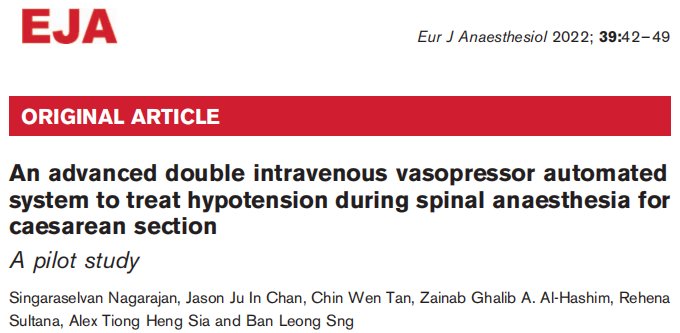关注罂粟花,共同学习麻醉最新文献!
一种先进的双静脉血管自动加压系统用于治疗剖宫产腰麻期间的低血压:一项试点研究

文章插图
贵州医科大学 麻醉与心脏电生理课题组
翻译:马艳燕 编辑:马艳燕 审校:曹莹
背景
在剖宫产腰麻期间,血流动力学不稳定可能导致母体和胎儿并发症。我们通过使用连续血压和心率监测器开发了一种新型的先进静脉内血管加压药自动化系统(ADIVA)。低血压的治疗基于三个标准:根据心率选择药物去氧肾上腺素或麻黄碱;血管加压药的剂量由低血压的程度决定;分别根据SBP的负梯度或正梯度变化快速或缓慢地使用加压药。
目的
这项试点研究的目的是研究ADIVA算法的可行性。
设计
前瞻性试点研究。
设置
新加坡的单一妇产科中心。
受试对象
在腰麻下接受择期剖宫产的妇女。
罂粟摘要 SPRING
干预措施:根据使用无创连续血流动力学监测仪(Nexfin)在连续无创血流动力学监测中检测到的血压和心率变化(通过ADIVA算法)自动给予麻黄碱或去氧肾上腺素。
主要结局指标:主要结局指标是低血压的发生率,定义为 SBP 低于基础值的80%。次要结局指标是反应性高血压、总血管加压药需求量、母婴结局以及系统评价。
SPRING 遇见春天
结果:共纳入四十五名妇女。31名女性(69.9%)至少有一次低血压。SBP在基础值的±20%以内,测量的平均SD为79.7±17.6%。44名(97.8%)妇女在分娩前需要去氧肾上腺素,而15名(33.3%)妇女需要麻黄碱。不需要任何抢救药物。三名妇女(6.7%)出现恶心,两名出现(4.4%)呕吐。所有新生儿在出生5分钟时的APGAR评分均为9分。
结论:ADIVA系统具有连续无创血流动力学监测功能,能够在绝大多数测量中将母亲SBP维持在基础值的±20%以内。该系统具有良好的母婴结局,主治麻醉医生的干预最少。
原始文献来源
Nagarajan S, Chan JJI, Tan CW, et al. An advanced double intravenous vasopressor automated system to treat hypotension during spinal anaesthesia for caesarean section: A pilot study. Eur J Anaesthesiol. 2022 Jan 1;39(1):42-49.
【 【罂粟摘要】一种先进的双静脉血管自动加压系统用于治疗剖宫产腰麻期间的低血压:一项试点研究】 SPRING
英文原文:
An advanced double intravenous vasopressor automated system to treat hypotension during spinal anaesthesia for caesarean section
A pilot study
BACKGROUND During spinal anaesthesia for caesarean section, haemodynamic instability may lead to maternal and foetal complications. We developed a novel advanced double intravenous vasopressor automated system (ADIVA) by using a continuous blood pressure and heart rate monitor.Treatment of hypotension was based on three criteria: the drug (phenylephrine or ephedrine) according to the heart rate; the dose of vasopressor determined by the degree of hypotension; a fast or slow bolus of vasopressor administered depending on whether there was a negative or positive gradient of SBP changes, respectively.
OBJECTIVE The aim of this pilot study was to investigate the feasibility of the ADIVA algorithm.
DESIGN A prospective pilot study.
SETTING Single obstetrics and gynaecology centre in Singapore.
PATIENTS Women undergoing elective caesarean delivery under spinal anaesthesia.
INTERVENTION Automated administration of ephedrine or phenylephrine based on changes in blood pressure and heart rate (via the ADIVA algorithm) detected on continuous noninvasive haemodynamic monitoring using noninvasive continuous haemodynamic monitor (Nexfin).
MAIN OUTCOME MEASURES The primary outcome was the incidence of hypotension, defined as SBP less than 80% of baseline. The secondary outcome measures were reactive hypertension, total vasopressor requirement, maternal and neonatal outcomes and system performance.
RESULTS Forty-five women were recruited. Thirty-one women (69.9%) had at least one reading of hypotension. SBP was within ?20% of the baseline in a mean+SD of 79.7+17.6% of measurements. Forty-four (97.8%) women required phenylephrine before delivery, while 15 (33.3%) required ephedrine. No rescue medications were required. Three women (6.7%) had nausea and two (4.4%) vomiting. All neonates had APGAR scores of 9 at 5 min.
CONCLUSION The ADIVA system, with noninvasive continuous haemodynamic monitoring, was able to maintain maternal SBP within +20% of baseline for the vast majority of the measurements. This system had good maternal and foetal outcomes with minimal intervention from the attending anaesthetist.
- 有毒|【提醒】致命毒蘑菇高发季,路边蘑菇不要采!
- 医疗机构|安徽霍山:开启“日间病床”就医新模式
- 空腹血糖|谁说糖尿病人不能吃水果
- 被称为“候鸟天堂”的海南,专家却说北方人不适合过冬?为什么?
- 青少年|青少年抑郁症有哪些前兆
- 慢特病|扩大医保药品目录,青岛将国谈药品对应病种纳入门诊慢特病管理
- 硝酸甘油片|“救命药”硝酸甘油片该怎样用?
- 维【涨知识】医生终于透露了熬夜的7大“好处”
- 班车|“慢性病服务”班车开进乡村
- 科普|防疫科普:科学洗手 时间不得少于20秒
